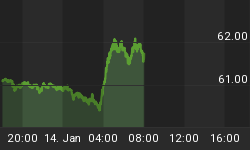Below is an excerpt from a commentary originally posted at www.speculative-investor.com on 12th September, 2010.
There is regularly talk about the Fed (or Treasury) devaluing the US dollar, but how do you devalue something that doesn't have a fixed measurement? Specifically, what would the Fed/Treasury devalue the dollar against and how would they go about it? In a recent interview with Eric King, Jim Rickards posits that the Fed could bring about a general dollar devaluation by using its open market operations to bid up the gold price, the idea being that devaluing the dollar against gold would scare people out of dollars and thus cause a reduction in the dollar's purchasing power. Would this work?
Well, if the Fed started bidding up the gold price it would definitely scare a lot of people, but by itself it couldn't bring about a sustained reduction in the dollar's purchasing power. To explain why we first need to quickly revisit the over-used concept of money "velocity".
When people talk about a change in money velocity what they really mean is a change in money demand. As is the case with the values of all economic goods, the value of money is influenced by changes in both supply and demand. For example, an increase in the supply of money wouldn't lead to a fall in the value of money if it were offset by an equivalent increase in the demand for money (often described as a reduction in money "velocity"). For another example, a reduction in the demand for money (often described as an increase in money "velocity") could bring about a reduction in money purchasing power (a general increase in prices) even if there were no change in money supply. However, whereas economic goods other than money are often subject to permanent changes in demand that are separate from (that is, not caused by) changes in supply, if the money supply is stable then changes in money demand will almost always be temporary. Consequently, it is not possible for a currency to experience hyperinflation, and it is extremely unlikely that a currency could experience a large and sustained reduction in its purchasing power, in the absence of a large increase in its supply.
The implication of the above is that the Fed couldn't cause a sustained devaluation of the dollar by scaring people into spending more dollars. There would also have to be a large expansion in dollar supply. In the absence of greater dollar supply, an economy-wide increase in prices couldn't be sustained because it would lead to a shortage of money.
The historical episodes of hyperinflation that we know of consisted of rapidly falling money demand alongside rapidly rising money supply. In general terms, what tends to happen is that after many years of persistently high monetary inflation, people begin to anticipate future monetary inflation. That is, people begin to factor the effects of the expected future increases in the money supply into today's prices, causing prices to rise faster than the money supply. This creates a perceived shortage of money, which the central bank addresses by boosting the money supply. But this only reinforces the public's fears of future currency depreciation, so prices begin to rise even faster. The feedback loop continues until the currency becomes completely worthless or until the central bank stops the expansion of the money supply.
With the above in mind it can be seen that the Fed could not possibly engineer a sustained GENERAL rise in prices by devaluing the dollar relative to gold. Absent an increase in the money supply, a sustained increase in prices in one sector of the economy would have to be offset by a fall in prices somewhere else in the economy. Devaluing the dollar relative to gold while leaving the money supply unchanged would simply transfer wealth to gold owners and the gold mining industry, which we suspect would not fulfill the wishes of those in power.
With the above in mind it can also be seen that a general devaluation of the dollar WILL occur if the Fed continues to ramp up the supply of dollars. The effects of the supply increase on money purchasing power (the general price level) can be, and often are, temporarily counteracted by increased demand for money, but if the money supply continues to increase then prices will eventually follow. Of course, as we've discussed in many previous commentaries prices will never follow in a uniform manner. Instead, some prices will respond earlier and more vigorously than others.
We aren't offering a free trial subscription at this time, but free samples of our work (excerpts from our regular commentaries) can be viewed at:http://www.speculative-investor.com/new/freesamples.html















